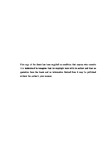TOWARDS THE GROUNDING OF ABSTRACT CATEGORIES IN COGNITIVE ROBOTS
| dc.contributor.supervisor | Cangelosi, Angelo | |
| dc.contributor.author | Stramandinoli, Francesca | |
| dc.contributor.other | School of Engineering, Computing and Mathematics | en_US |
| dc.date.accessioned | 2014-09-08T14:59:53Z | |
| dc.date.available | 2014-09-08T14:59:53Z | |
| dc.date.issued | 2014 | |
| dc.date.issued | 2014 | |
| dc.identifier | 10283385 | en_US |
| dc.identifier.uri | http://hdl.handle.net/10026.1/3099 | |
| dc.description.abstract |
The grounding of language in humanoid robots is a fundamental problem, especially in social scenarios which involve the interaction of robots with human beings. Indeed, natural language represents the most natural interface for humans to interact and exchange information about concrete entities like KNIFE, HAMMER and abstract concepts such as MAKE, USE. This research domain is very important not only for the advances that it can produce in the design of human-robot communication systems, but also for the implication that it can have on cognitive science. Abstract words are used in daily conversations among people to describe events and situations that occur in the environment. Many scholars have suggested that the distinction between concrete and abstract words is a continuum according to which all entities can be varied in their level of abstractness. The work presented herein aimed to ground abstract concepts, similarly to concrete ones, in perception and action systems. This permitted to investigate how different behavioural and cognitive capabilities can be integrated in a humanoid robot in order to bootstrap the development of higher-order skills such as the acquisition of abstract words. To this end, three neuro-robotics models were implemented. The first neuro-robotics experiment consisted in training a humanoid robot to perform a set of motor primitives (e.g. PUSH, PULL, etc.) that hierarchically combined led to the acquisition of higher-order words (e.g. ACCEPT, REJECT). The implementation of this model, based on a feed-forward artificial neural networks, permitted the assessment of the training methodology adopted for the grounding of language in humanoid robots. In the second experiment, the architecture used for carrying out the first study was reimplemented employing recurrent artificial neural networks that enabled the temporal specification of the action primitives to be executed by the robot. This permitted to increase the combinations of actions that can be taught to the robot for the generation of more complex movements. For the third experiment, a model based on recurrent neural networks that integrated multi-modal inputs (i.e. language, vision and proprioception) was implemented for the grounding of abstract action words (e.g. USE, MAKE). Abstract representations of actions ("one-hot" encoding) used in the other two experiments, were replaced with the joints values recorded from the iCub robot sensors. Experimental results showed that motor primitives have different activation patterns according to the action's sequence in which they are embedded. Furthermore, the performed simulations suggested that the acquisition of concepts related to abstract action words requires the reactivation of similar internal representations activated during the acquisition of the basic concepts, directly grounded in perceptual and sensorimotor knowledge, contained in the hierarchical structure of the words used to ground the abstract action words. | en_US |
| dc.description.sponsorship | This study was financed by the EU project RobotDoC (235065) from the Seventh Framework Programme (FP7), Marie Curie Actions Initial Training Network. | en_US |
| dc.language.iso | en | en_US |
| dc.publisher | Plymouth University | en_US |
| dc.subject | Abstract Words | |
| dc.subject | Symbol Grounding | |
| dc.subject | Developmental Cognitive Robotics | en_US |
| dc.title | TOWARDS THE GROUNDING OF ABSTRACT CATEGORIES IN COGNITIVE ROBOTS | en_US |
| dc.type | Thesis | |
| plymouth.version | Full version | en_US |
| dc.identifier.doi | http://dx.doi.org/10.24382/3511 |
Files in this item
This item appears in the following Collection(s)
-
01 Research Theses Main Collection
Research Theses Main


